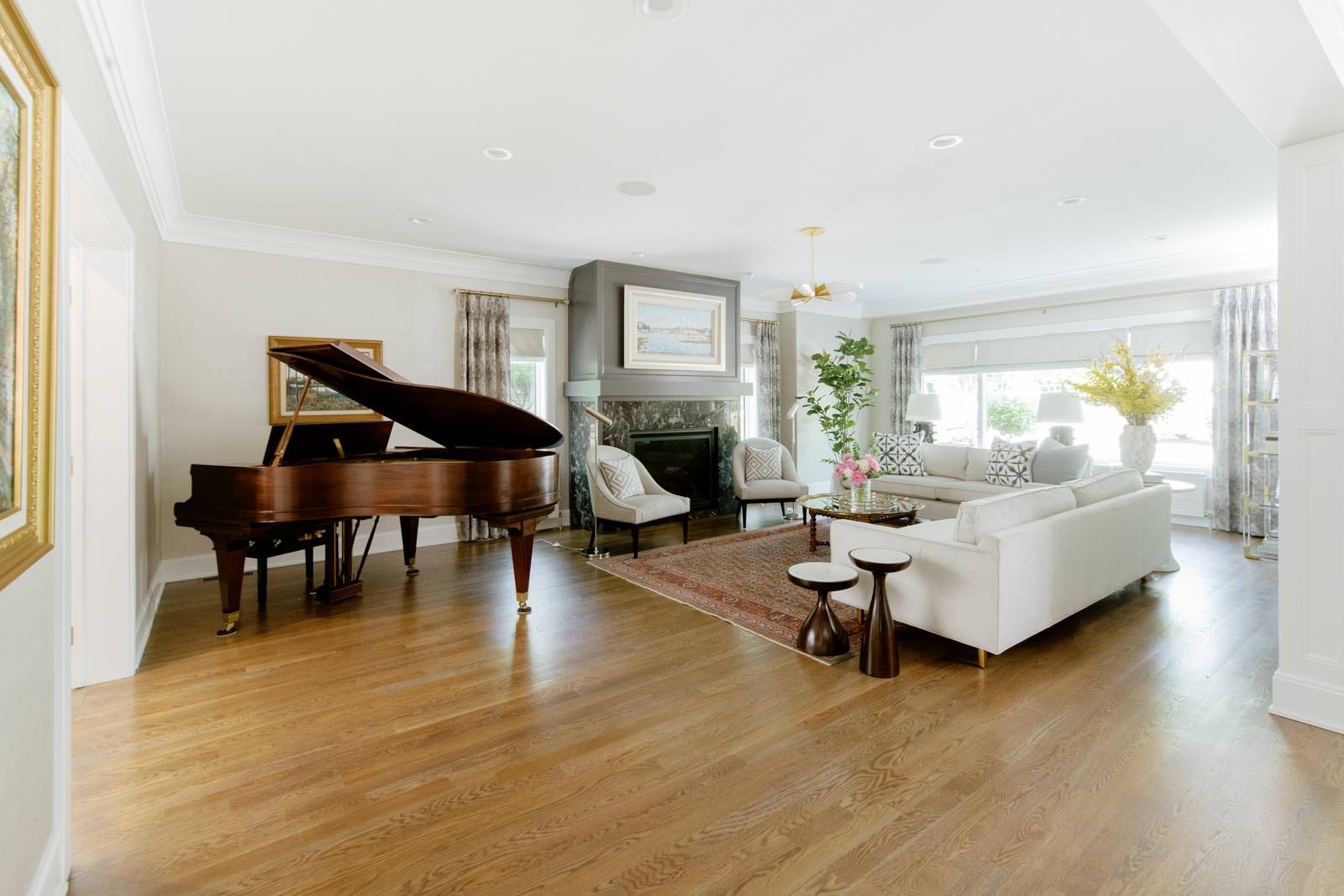10 Interior design styles defined
To help create a vision for your home that aligns with your personal taste, it’s important to understand the design styles to guide you or your interior design team. There are dozens of styles that have their own individual characteristics and influences to consider. The Jeid Studio team has identified some of the most common (and of course, our personal favorites) design styles to help you determine which aesthetic may fit you best.
Traditional
Traditional styles are known for being elegant, timeless, and formal because of their inspiration from 18th and 19th Century Europe. Homeowners who appreciate antiques and classic art, with the freedom to add modern twists, appreciate traditional styles. Some common elements found are repeated patterns, symmetrical layouts, and structural embellishments (columns, crown molding, and coffered ceilings). For those who are fans of the movie Home Alone, the McCallister family has a beautiful traditional-style home!
Common elements/features: detailed woodwork, rich wood tones, curved and graceful lines
Color palette: neutral colors with rich pops of color
Why we love this style: It’s the most timeless option that will never go out of style.
Modern
Developed from industrialization and urbanization in the late 19th and early 20th Century, modernism represents clean, sleek, and simple design. Materials include glass, iron, steel, and concrete. The modern interior design style focuses more on functionality than form.
Common elements/features: Open concept, large windows, geometric shapes, and minimal decor
Color palette: black, white, or neutral colors with a bold color contrast (especially with art and furniture)
Why we love this style: A less is more mentality.
English/Cottage
English-style homes are fitting for those looking to be cozy and comfortable—it’s great for small spaces! This style was popular for English farmers, resulting in distressed or weathered wood, stone, and cotton materials often used. This style is great for those who love soft materials and cozy fireplaces.
Common elements/features: Plush furniture, charming decor, and detailed woodwork
Color palette: white or cream, neutrals, pastels, or muted tones
Why we love this style: Cozy, warm, casual, inviting and laid back.
Transitional
Transitional is one of the more popular styles among current homeowners because of its ability to combine elements from both traditional and modern styles. It emerged in the 1950s by those who felt modern alone was too striking. As a result, they pulled in elements from traditional to create a balance between the two.
Common elements/features: often more traditional pieces using darker wood paired with more streamlined, yet comfortable furniture
Color palette: neutral colors as a base; color additions through textiles and a few accessories
Why we love this style: It works well in almost any style of home.
Contemporary
Contemporary refers to the style that follows the trends and what is popular now (hence the name). This means the style is ever-evolving and fluid. It blends a variety of styles together, so it speaks to the identity of the homeowner more than anything. Typically, the style incorporates a lot of natural light, open spaces, and neutral colors, with a calm and minimal feeling. Contemporary styles are a great platform for a designer or a homeowner to express themselves.
Common elements/features: Lots of natural light and open spaces. Produces a calm and minimal feeling
Color palette: neutral colors with subtle drama and hints of color
Why we love this style: For those who love a calming and relaxed space.
Coastal
Here’s the style for all beach lovers! Coastal designs have a strong sense of identity because of their association with the coast. Just like the beach, they have a light, airy, and breezy feel to them. Materials used are weathered wood, linen, and cotton, but it’s famous for its use of jute, wicker, and rattan. Coastal designs are a great way to have fun and decorate according to your environment.
Common elements/features: natural light, minimal window treatments, fun patterns and decor, and plenty of plants
Color palette: Neutral tones with coastal colors (green, aqua, turquoise, beige/khaki)
Why we love this style: It’s environmentally influenced which creates a fun way to play with textures, colors, etc.
Scandinavian
Scandinavian became popular in the early 20th century throughout the Nordic countries of Denmark, Norway, Sweden, Finland, and Iceland. Like modern, it embraces simplicity and minimalism but separates itself by taking those elements to another degree. It removes unnecessary materials and space in favor of utility over luxury. Art galleries represent Scandinavian well because of their use of light wood floors and white walls. Things that look good, function efficiently, and feel organic belong in Scandinavian.
Common elements/features: Light wood tones, natural materials
Color palette: White, gray, beige
Why we love this style: It’s minimal but has its own unique voice.
Industrial
When the industrial revolution took off, factories built in the previous century were no longer needed and turned into residential spaces as a result. Industrial-style homes use raw materials like brick, pipes, ducts, or beams to their advantage. Taking inspiration from old warehouses and factories, the goal is to combine that inspiration with other design styles. In the end, industrial has a textured, rustic, and ‘heavy’ feel. that uses open floor plans, high ceilings, and either vintage or modern furniture.
Common elements/features: Open floor plans, high ceilings, and either vintage or modern furniture.
Color palette: Cool and rustic (rich reds, browns, etc.)
Why we love this style: It’s rough around the edges which can lend itself to rustic looks.
Hamptons
Hampton-style homes are all about being grand, sophisticated, and clean. With elements of coastal design, Hampton homes are the more residential version of that style. These homes pop with bright whites and dark accents. are common; light blues and different shades of taupe are found as well. The movie Something’s Gotta Give represents a beautiful Hampton home!
Common elements/features: Paisley and geometric patterns, architectural elements, plants, and landscaping
Color palette: White, light blues, and different shades of taupe.
Why we love this style: When traditional and coastal collaborate.
Bohemian
The bohemian style is known for its free-spirited, unconventional take on design. It cares less about order and more about uniqueness and self-expression. Bohemian is the perfect style for those who like an earthy and warm atmosphere, with room for cultural expression.
Common elements/features: Plants and greenery, rich woodwork, lush fabric, fun patterns, and combined textures
Color palette: Really anything the designer wants, but it has to be bold!
Why we love this style: Bohemian is perfectly imperfect. Scratches, chips, marks, etc. all enhance the bohemian-ness. It’s a playground for color and texture.
Did you discover your interior design style?
If you did, we hope this empowers you to be better equipped to select decor and accessories that best fit your personal style and preferences. If you are still unsure, that’s why our team at Jeid Studio is here to help! We are happy to guide you through any design challenges you may have. Feel free to fill out our PROJECT INQUIRY FORM to fill us in on your project and to start a consultation.







